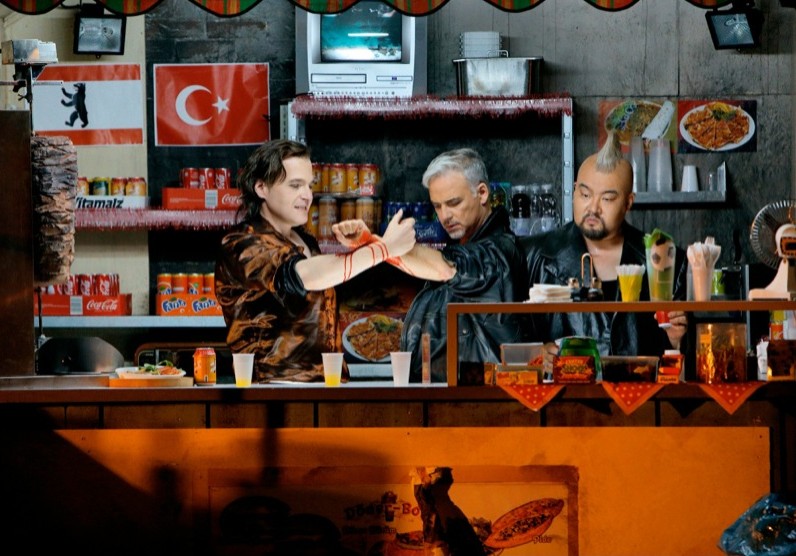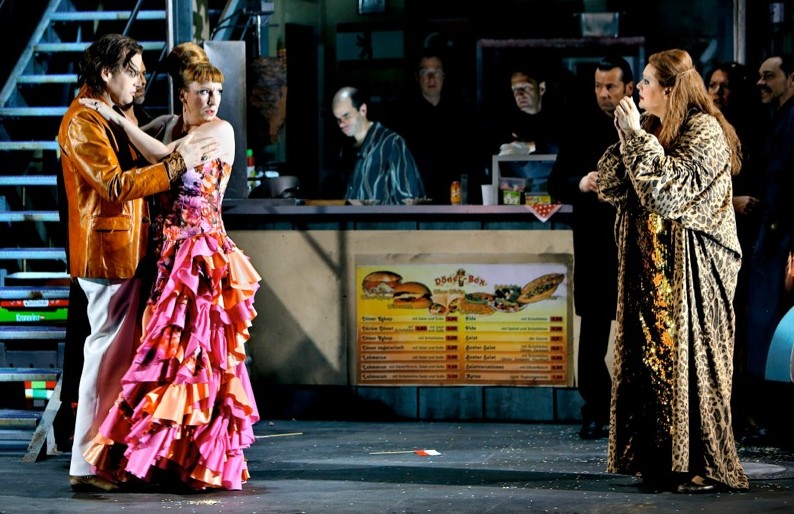Wagner’s Ring: Siegfried and Götterdämmering, Bayreuth, August 2013
Posted on 20 August 2013The overall conception of this production is seediness, but the main problem is a failure of dramaturgy and linkage to the music.

Siegfried Act I, all images Enrico Nawrath
There is a sword, originally held by Siegmund, but Siegfried uses a machine-gun for killing Fafner, and although Hagen brings out a spear for the opposing oaths of Brünnhilde and Siegfried, he simply clobbers the hero with a baseball bat. Presumably director Frank Castorf includes the original murder weapons because he cannot change the text, and nor can he change the music, though he certainly seems to treat it as secondary.
In my review of Rheingold and Walküre I mentioned the video cake-eating episode during the musical high point between Siegmund and Sieglinde. Then at the end of Siegfried during the love duet two crocodiles appear. One of them devours the Woodbird, already shorn of the magnificent plumage she wore while having sex with Siegfried, though he is gentleman enough to pull her out at the end. In the meantime the lovers take turns to shove a furled umbrella into the mouth of the other crocodile, as they sit desultorily at the same café table where Wotan earlier consumed four bottles of wine with Erda … before she gave him a blow-job.

Siegfried and Woodbird
These episodes took place at the Alexander Platz in East Berlin during the days of the DDR, a time and place emphasized in other ways, not obvious to non-Germans. One was the brightly lit Minol sign in Siegfried, alluding to the East German gas stations, and another was the huge sign in Götterdämmerung referring to Plaste and Elaste, which appeared at the half-way point on the north-south cross route between Berlin and West Germany. East Germany was big on plastics, and oil is one of the themes of this Ring, emphasised by the location of Walküre in Azerbaijan.

Love in the Alexander Platz
Yet the only consistent theme is seediness. As Brünnhilde sings Ewig war ich … after the brief musical interlude connected with the Siegfried Idyll, she sits on an open spiral staircase, while some woman works at a post-office counter behind. Oh, sorry … that was no woman, it was Siegfried with necklace and long hair that he perpetually swept away from his face. What was the point, and why does Siegfried fall asleep on stage in Götterdämmerung while we hear his horn calls to the Gibichings?

Blood brotherhood: Siegfried, Gunther, Hagen
During the Funeral March we see a video of Hagen walking through sun-dappled woodland, but this was a bald Hagen without the coxcomb of hair he has on stage — presumably antedating some of the costume decisions. It was a cheerful video at odds with the music, just one of many ideas thrown into the pot. Another was the baby doll that Brünnhilde handed to Siegfried, and the baby carriage that was later sent tumbling down the staircase spilling potatoes all over the place. Here was a clear allusion to the Odessa Steps episode in Eisenstein’s movie Battleship Potemkin, occurring at the same time as the decision to kill Siegfried — make of that what you will, but why the potatoes?
As to the music, the singers were a mixed crowd, with the real heroes being Kirill Petrenko in the orchestra pit, and Catherine Foster as Brünnhilde. She swept all before her, despite the production’s best efforts to undermine her impact. As she launched into Starke Scheite we see a video of Gutrune grinning as if high on drugs, and then see her fleeing up the stairs howling with laughter.

Siegfried, Gutrune, Brünnhilde
Among other first rate performers were Alejandro Marco-Buhrmester as Gunther, and Allison Oakes as Gutrune. Lance Ryan as Siegfried started strongly enough in the first scene with Burkhard Ulrich’s strongly sung Mime, but seemed unable to give much lyricism to softer passages later, and the other big disappointment was Attila Jun’s dreary Hagen. Mirella Hagen gave us a prettily sung Woodbird, and Claudia Mahnke, who sang Fricka in the first two operas, came over as a very strong Waltraute, and second Norn. Martin Winkler was a powerful Alberich, and Wolfgang Koch gave a far stronger performance as the Wanderer than he did as Wotan in the previous two operas. Fine singing too from the splendid chorus in Götterdämmerung.
Uneven casting, but no expense spared on the magnificent sets by Aleksandar Denić, which were built in Hamburg rather than in-house because of time constraints. I particularly liked the four faces of Communism (Marx, Lenin, Stalin, Mao), modelled on America’s Mount Rushmore memorial, and it was a clever idea to cover the façade of the New York Stock Exchange with a vast cloth, reminiscent of the Reichstag during its renovation. In front of it in Act III was a superb old Mercedes imported from America, in which sat the Rhinemaidens, who engage in kissing sessions with Siegfried, and later Gunther. They are still around when the cloth falls and Hagen turns up, baseball bat hidden behind his back.

Final scene
In front of the Stock Exchange, Brünnhilde hands over the Ring to the tarty Rheinmaidens, and immediately the last chord was over the booing started, as it has for every opera in the cycle. There was a good break for appreciation of the singers, but it started again at the end of the curtain calls.
It is one thing to have bold new ideas for the Ring, but Frank Castorf seems to lack the musicality to make them work.
For a review of Rheingold and Walküre click here.

